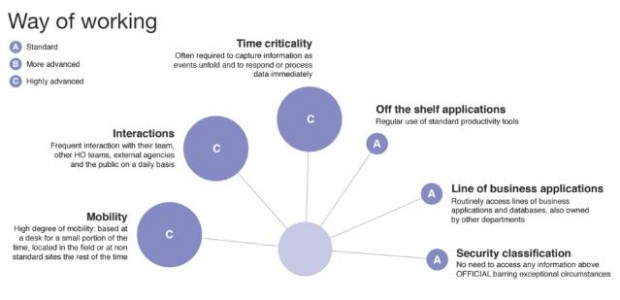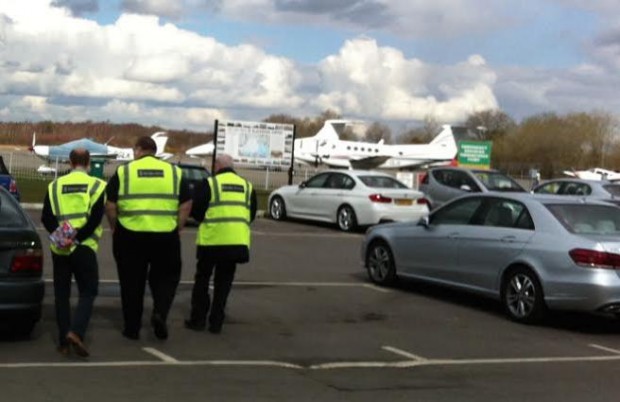The GDS Common Technology Services (CTS) team was set up following the Cabinet Office Transformation Programme. We want to explore the best ways to run technology transition projects in other government departments.
The Home Office is a big and complex department, employing approximately 32 thousand people. Its shape frequently changes, with teams moving, merging or in some cases becoming a completely separate body.
The team responsible for the Home Office transformation wanted to better understand the needs of their staff by exploring their daily tasks, how they work throughout the organisation, and how they would like to work in the future.
To answer these questions, the Home Office and CTS created a cross-departmental user research team to start the discovery phase.
How user research fits in
When researching such a big and dynamic organisation we couldn’t afford to be too granular in our findings. We had to find similarities and differences in how people work across the organisation. The divisions existing in government are rarely stable so we wanted to produce outcomes that will outlive these changes.
What we did
Our team of user researchers spoke to staff in a variety of roles throughout the Home Office. We visited them in many locations, from offices, to border controls, to out in the field (literally!).
We took cameras, recording equipment, and a discussion guide of the topics we wanted to cover. We listened to people’s stories about the way they work, how they use technology successfully, and where it lets them down. On our return we discussed our experiences with each other and shared our findings with the rest of the team. By the end of our fieldwork we’d spoken to over 400 members of staff, visited nearly 40 Home Office locations across the country, and called many more employees.
User profiles
What became rapidly clear is that staff were working in similar styles and facing similar challenges regardless of their team, role, seniority level or location. We could often describe people in terms of their ways of working throughout any given day. This included the degree to which they had to move around an office location, multiple locations or to different places around the country.
Other common themes were the predominant use of off-the-shelf applications (like email, Microsoft office suite, and publishing tools) to accomplish tasks, or dependence on departmentally owned bespoke tools (like admin applications, case work tools, expenses and intranet).
We were able to group the people we spoke with into these, and other repeated themes, which became the core dimensions on which we could build our profiles.
We’ve come up with seven profiles (so far): Behind the Scenes, Office Everywhere, Speedy Checkers, Out and About, Front of House, Technologist and Always On. These each have their own unique pattern, which represent the way that staff at the Home Office currently work and use technology.
For instance a ‘Speedy Checker’ staff member spends much of their day mobile, responding to events as they occur and interacting with a wide range of people. The border staff checking freight at a port are a good example. Whereas a ‘Behind the Scenes’ staff member works from a fixed location, processing information in a predetermined fashion in order to achieve a business objective, for example processing a Visa application.

Next steps
The project in the Home Office finished this summer (2015), but this doesn’t mean the outcomes of our work have been forgotten. Currently the profiles are used by CTS at GDS, but the goal is to see whether the profiles are replicable in other departments - do ‘Office Everywhere’ employees exist in other departments too? If so, in what proportion to other profiles?
This is not a final collection of profiles. We think that some of them may end up merged and that new profiles will become evident. We want to build a coherent understanding of cross government users and find out how these profiles look on a bigger scale. The user researchers at CTS are engaging with other departments and our aim is to support any technology transition discovery work that is kicking off across government.
By discovering the way people work across government - what is successful, what is a blocker - we, at CTS, can suggest solutions to remove barriers and preserve the good work already being done. Not all of the CTS solutions will be technical, sometimes they will be a policy change or a service design solution. They will, however, always put the user first.
You’ll be able to follow our work on this blog and other government blogs: Government Technology and Home Office Digital. Also, if there are any departments and agencies looking to start or expand on their own user research in technology you can contact us via contact.cts@digital.cabinet-office.gov.uk
Follow GDS on Twitter and don't forget to sign up for email alerts.



5 comments
Comment by Digital KoolAid posted on
It s logical that "The team responsible for the Home Office transformation wanted to better understand the needs of their staff by exploring their daily tasks", however perhaps not as benign as it initially seems. The business case presented by the GDS was based upon sacking civil servants. It is necessary to understand what these people do before they can be off-loaded to the dole queue. Yes, new jobs currently exist "discovering" what people already know in order to remove them, but perhaps few, and although "this is not a final collection of profiles" you cannot expect to stay on your CTS assignment forever. You too will run out of time.
Comment by Isobel Cave posted on
Echoing Steve's comment - is there a way to get some more detail on the research that was carried out for this project?
Comment by Martin Voelkening posted on
I would love to see more details on the 7 different types. Would it be possible to share those? Thanks.
Comment by Steve Mallinson posted on
Really interested in this piece 'discovering the way people work'. Is it linked to the Cabinet Office's (GPU) The way we work (TW3 ) programme? It would appear from the photograph that there are details for each of the 7 profiles identified by the research, are these details available to view and if so how can I access them? I would like to be kept up to date with developments on this research, is that possible?
Comment by Anna Wojnarowska posted on
Hi Steve,
Thank you for your comment. GDS user researchers are working with GPU on a couple of different projects. When it comes to TW3, I'm in touch with the team in the Home Office who is using the information we collected during this research as a foundation for their engagement with the department. We will continue to publish our findings and answer as many questions as possible. Anna